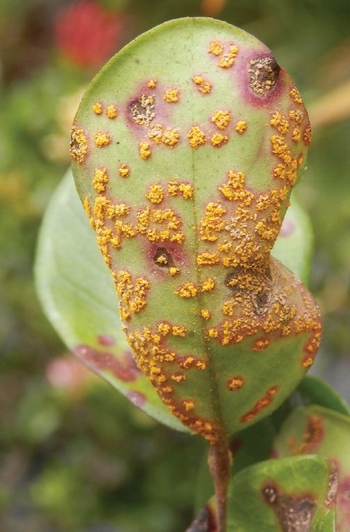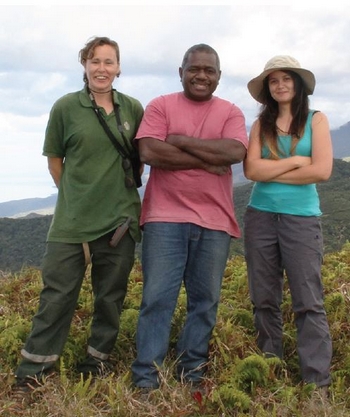PESTS AND DISEASES OF FORESTRY IN NEW ZEALAND
Myrtle rust help: from New Caledonia to New Zealand
From Forest Health News 282, July 2018.

Armed with experience of myrtle rust tracking in New Caledonia, I (Julia Soewarto) recently joined the Forest Protection team at Scion as a Postdoc. Before joining Scion, I completed a PhD on myrtle rust in New Caledonia, which combined ecology, genetics and plant pathology. My PhD research concentrated on identifying the host and geographic ranges of myrtle rust in New Caledonia, as well as assessing the level of genetic diversity in the pathogen population. I also evaluated native and exotic Myrtaceae for their susceptibility to myrtle rust and worked on plant selection for resistance using a RNA-sequencing approach.
The main results of my work showed that myrtle rust significantly threatens New Caledonia’s biodiversity, with at least 67 endemic host species identified (26% of the known species of Myrtaceae in NC). The disease has been found in six different types of native ecosystem, ranging from ultramafic maquis to rainforest, and including the highly endangered sclerophyll forest. Nurseries were also severely impacted by the disease from the first year of its incursion. Therefore myrtle rust is considered as a significant threat to New Caledonian ecosystems and the Myrtaceae-related economy.
The population genetic study revealed that only one single genotype of Austropuccinia psidii (cause of myrtle rust) was introduced to New Caledonia and it occurs across a wide host range. However, it is essential to carry out population genetic surveillance in future to identify the appearance of mutations or the introduction of potentially more virulent or aggressive genotypes of A. psidii.

A three-year disease monitoring trial with 35 cultivated species of Myrtaceae showed variations in disease susceptibility between individuals. This suggests that some level of genetic resistance to myrtle rust may exist among species of Myrtaceae in New Caledonia. This shows the potential to select for resistance in future breeding programmes.
Finally, RNA-sequencing of the response to infection by three species of Myrtaceae identified several interesting genes linked to plant defence systems. These results are the first step to a marker-assisted selection process that would help to identify resistant host genotypes and provide a means of maintaining production of Myrtaceae in nurseries.
In New Zealand, my Postdoc research will involve the surveillance of myrtle rust in infected areas, plant host testing for susceptibility level to the disease, and improving disease management through development of biological control tools.
Julia Soewarto (Scion)

 Farm Forestry New Zealand
Farm Forestry New Zealand

